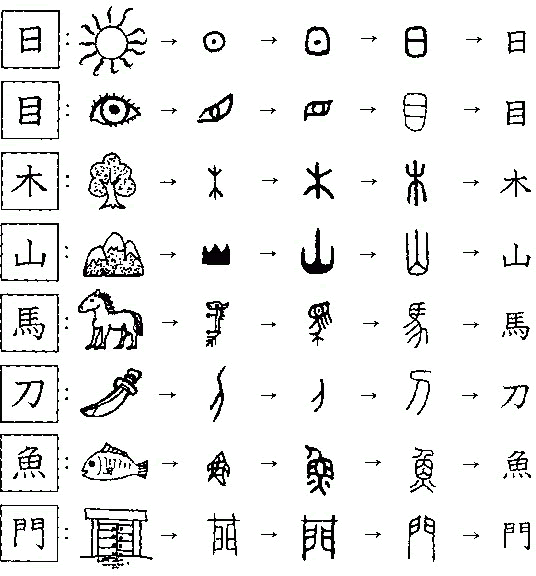Growing up, I have always dreaded Chinese language classes. With its complicated system that was different from what I was learning in English classes, I struggled to learn the language. As I’ve grown to learn and love the language and its origins, I was excited when it was briefly introduced in class, thus my research on the evolution of the written language in Asia.
Derivation of Logograms
Chinese logograms in their earliest form would be pictograms. These pictograms originated from observation of the physical form. For concepts or intangible ideas, ideograms were introduced into the language to be able to present them in written form. Concepts such as direction, for example, “up” and “down” would look like “上” and “下” respectively. Its visuals would try to emulate the concept as directly as possible. In the character for “up”, its stem protrudes from the base, and for the character for “down”, its stem to hang from the base.

https://www.omniglot.com/images/writing/character_origins.gif
How Logograms become Simplified
Over time, these logograms with complicated strokes would fall into a system so that it would be easier to draw similarities and understand the character faster. Radial compounds were introduced while simplifying the language. The function of these would be that it would suggest the overall meaning of the character. For example, the character for vegetable, “菜”, its header, “艹“ known as the grass radial header, suggests that the character is related to plants or flowers. Meanwhile the body “采” would imply how the character would sound. This method helped me tremendously in my Chinese oral tests when I had to guess characters that I have never seen in my life.
Chinese Text Reading Method
Although known for its different reading methods (up to down and right to left), do modern Chinese people still read texts this way? The short answer is no. For the entirety of my school life, I was taught to read texts from left to right. The long answer is that there are still some cultural items, such as signboards and novels, that preserve the traditional way of reading.

https://media-cdn.tripadvisor.com/media/photo-s/07/c2/a9/0c/hoe-kee-chicken-rice.jpg

https://chinesebilingual.files.wordpress.com/2018/03/img_0074.jpg?w=600&h=450
Conclusion
The Chinese language has developed its system for characters to be read with ease. The modern or simplified Chinese has this clean look, evolving from the complicated strokes that the logograms had. While its reading counterpart is simple, containing only 4 tones attached to a variety of pronunciations, it is almost impossible to tell what character is being said unless the listener has the full context of the sentence. The complexity of this language has led me to acknowledge that my struggle to learn was valid, and to appreciate its beauty.
Reference
Chinese writing system. (2017). Encyclopaedia Britannica, Britannica concise encyclopedia. Britannica Digital Learning. Credo Reference: https://ezproxy.capilanou.ca/login?url=https://search.credoreference.com/content/entry/ebconcise/chinese_writing_system/0?institutionId=6884
H. (2019). 草字头 Cao Zi tou: The Grass Radical. Written Chinese. https://www.writtenchinese.com/the-grass-radical/
(n.d.). Chinese characters. Wikipedia. https://en.wikipedia.org/wiki/Logogram#Chinese_characters